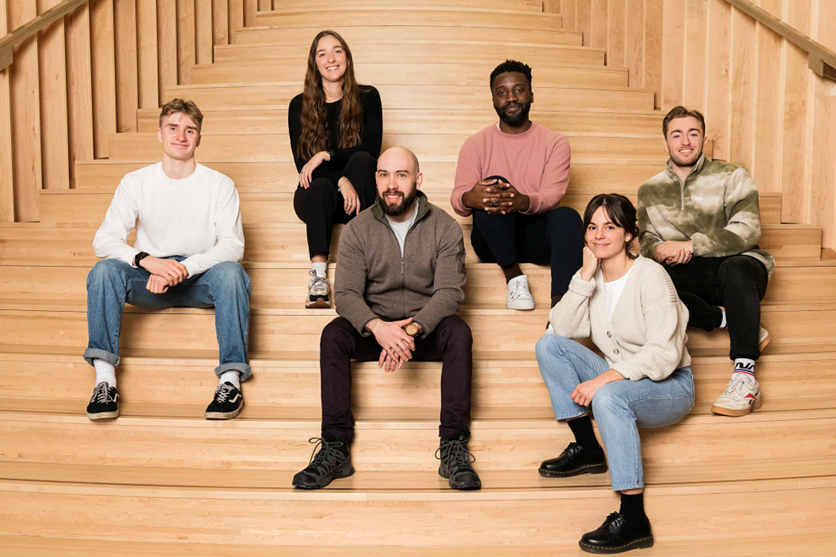Lighthouse: the light at the end of the metaverse

Users seeking to navigate the metaverse may end up needing a whole new toolkit. Lighthouse, a Montréal-based start-up, has designed a type of compass or beacon for users making their way around this brand-new universe.
Why is the metaverse such a rich source of dreams? Perhaps because it holds the promise of Web experiences that few of us have ever known. The reality, however, may be quite different: when you enter the metaverse, you’re very likely to get completely lost!
Lighthouse Labs is seeking to address that problem. Founded in Montréal in early 2022 by Jonathan Brun and Justine Massicotte, the young start-up is seeking to provide metaverse users with a tool so they can easily find the friends, creators, experiences, assets, places and events they are looking for, which is impossible with traditional search engines. Just a few months after it began operating, the company raked in at least USD 7 million in its initial investment round and began hiring its first staff. Today, Lighthouse has some 15 employees, most of whom are based in Montréal.
But where exactly does Lighthouse come from and where is it going? Interview with Jonathan Brun, the company’s co-founder.
Q: To really grasp Lighthouse’s vision, you first need to understand its target market: how would you define the metaverse?
JB: The metaverse is a series of three-dimensional digital spaces that users can navigate using various devices, including computers, smartphones or a 3D headset. These spaces host different worlds that users can enter alongside other people in the form of avatars. In addition to taking part in events, they can enjoy more richly textured experiences than they could on the traditional Web. Most importantly, the metaverse is a place where you can put in place assets and carry out transactions. This adds a financial dimension to these virtual spaces since value can be brought in and taken out.
For the time being, unfortunately, this universe remains fragmented: the various spaces are protecting their own territory and not communicating with each other. But we are actually focusing on a medium-term vision of an interconnected metaverse in which users can move around from world to world and carry out transactions transparently. Our vision is of an open metaverse based on platform interoperability.
Q: Do these new navigation spaces and experiences meet a real market need?
JB: The best way to grasp the metaverse’s potential and its power of attraction is to situate it within the evolution of the Internet itself. Originally, technology only allowed users to exchange text-based messages, although this did lead to the emergence of new tools such as blogs. Next came a succession of massive waves that brought us images and then videos. This fuelled the explosion of e-commerce and the advent of social media. Whenever the Internet has successfully accommodated more sophisticated media, patterns of use have changed radically. In our view, the metaverse represents a new wave in which the time we spend on the screens and the intensity of our experiences will change as new forms of behaviour appear. That opens up new horizons, particularly in terms of socializing, education, branding and marketing. And that is only possible thanks to the metaverse’s more richly textured media.
Q: So what role does Lighthouse want to play in this vision of the metaverse?
JB: Before founding Lighthouse, I was on the investment team of White Star Capital’s digital asset fund, where I saw the metaverse becoming an ever-closer prospect for the Internet. I started wondering about the opportunities opening up for a Web entrepreneur. I then became an “entrepreneur in residence” at White Star prior to founding Lighthouse with my business partner Justine. We essentially had one central idea: the way in which a search engine works had to be completely rethought for the metaverse.
Why? Because traditional search engines use “crawlers” to navigate the Web and index the information they find. This process doesn’t work in the 3D realm of the metaverse. Using crawlers, you cannot index content in real time, on a large scale or in all the worlds that make up the metaverse. There are too many abstractions in the data. For instance, where is the avatar we’re looking for? Where is it going? A new approach is needed to index this information. And seeing as the metaverse is still a highly fragmented reality, this is an opportunity for young players like Lighthouse to gain a foothold.
Q: Isn’t that ambitious? How will you go about doing that?
JB: To be honest, the first version of our approach involved inventing a kind of “Google Maps” for the metaverse, enabling users to move from virtual place to virtual place. Before too long, however, we came up with a more holistic vision of an actual search engine that would allow users not only to find places, but also people, creators, events, assets and experiences. To do so, we index a large quantity of information directly from the block chain. At the same time, we use application programming interfaces (API) to put in place direct connections with the various worlds of the metaverse. Being a young and neutral player helps us to sign agreements of that kind with companies that would otherwise tend to be wary of each other.

Q: Aren’t you worried you’re too small and too young to be operating in a “world of giants?”
JB: For now, we have the not-insignificant advantage of being the first company to put forward this kind of solution and to build interconnections between the various virtual worlds. Many other players are still hesitant: there aren’t many metaverse users and the market is not that obvious. We firmly believe that the metaverse is the next wave of the Web. A solution like ours is inevitable. We’ve taken an “adoption risk” that others aren’t willing to take, and that positions us advantageously. So I think we’re in the best position because we’ve taken the lead. We just need to keep setting the pace.
Q: What are the next steps and your main challenges?
JB : In the medium term, our goal is to set up a “creator hub,” which will aggregate indicators based on what users do in the metaverse. That way, more information and value will be delivered to the brands using our platform. Our long-term goal is to be the primary access point for all the experiences that the metaverse has to offer.
To achieve that goal, our main challenge has more to do with accessing talent than accessing capital. What we need to do is to attract developers who aren’t scared of an audacious young start-up! On that front, Montréal offers us a prime location, with its talent pool and entire ecosystem ranging from support to innovation.
Needless to say, our sectoral assumptions about the future and potential of the metaverse have to be correct. But we have the strength of our convictions. Alongside the other players in the sector, we will be uniquely positioned when that happens.
LIGHTHOUSE LABS AT A GLANCE
Founded in:
2022
Number of employees:
around 15
Product:
search engine based on the interoperability of the spaces making up the metaverse
Investment stage:
Seed
Most recent funding round:
2022 (USD 7 million)
Main investors:
Accel, BlockTower, Animoca, White Star Capital, Gemini Frontier Fund, StreamingFast, Alex Svanevik, Patricio Worthalter, Thibault Launay
Ambition :
To be the primary access point for all metaverse experiences